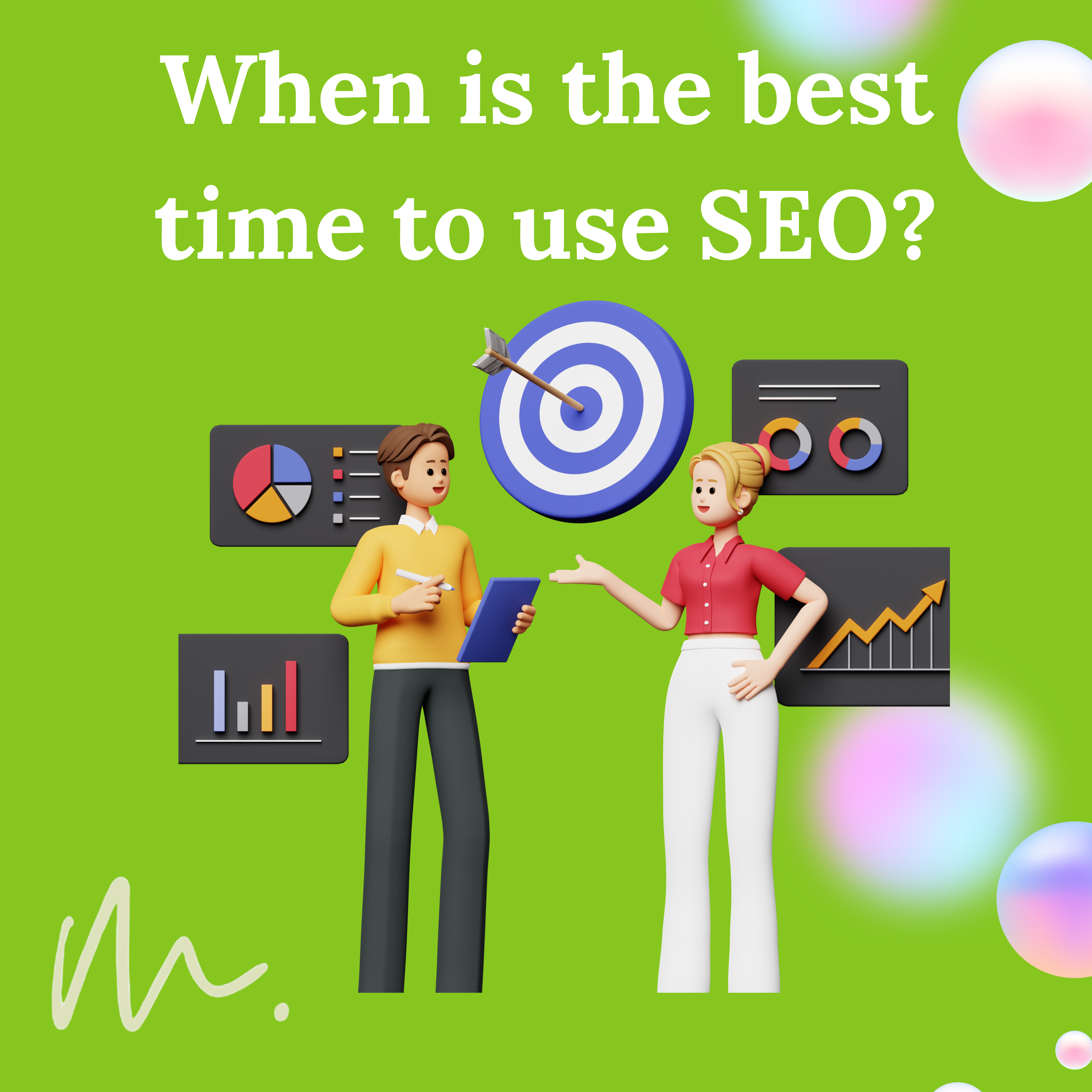When Is the Best Time to Use SEO?

When considering the best time to use Search Engine Optimization (SEO), it is essential to understand that SEO is not a one-time activity but an ongoing strategy that can significantly impact your online presence and business success. This blog will explore the optimal timing for implementing SEO, the various stages of a website’s lifecycle, and the factors that influence when to prioritize SEO efforts.
Understanding SEO
SEO encompasses a range of techniques aimed at improving a website’s visibility in search engine results. The primary goal is to attract organic traffic by optimizing content, improving site structure, and enhancing user experience. Effective SEO requires a deep understanding of search engine algorithms, user behaviour, and industry trends.
The Lifecycle of a Website
Pre-Launch Phase
Before launching a website, it’s crucial to conduct keyword research and develop an SEO strategy. This phase involves:
Keyword Research: Identify relevant keywords and phrases that potential visitors are searching for. Tools like Google Keyword Planner, SEMrush, and Ahrefs can help in this process.
On-Page Optimization: Ensure that the website structure, meta tags, headings, and content are optimized for the identified keywords. This foundational work sets the stage for better visibility once the site goes live.
Content Planning: Develop a content calendar that aligns with SEO goals. This includes planning blog posts, landing pages, and other content that addresses user needs and search intent.
Launch Phase
The launch of a website is a critical time for SEO. Implementing SEO strategies during this phase can significantly influence initial visibility and traffic. Key actions include:
Technical SEO: Ensure that the website is technically sound, with fast loading times, mobile responsiveness, and proper indexing. Use tools like Google Search Console to monitor performance.
Submit to Search Engines: After launching, submit the website to search engines and create a sitemap to facilitate indexing.
Social Media Promotion: Leverage social media platforms to promote the new website and drive traffic. This can help in gaining initial traction and backlinks.
Post-Launch Phase
Once the website is live, ongoing SEO efforts are necessary to maintain and improve visibility. This phase includes:
Content Marketing: Regularly publish high-quality, relevant content that addresses user queries and incorporates targeted keywords. This not only helps in ranking but also establishes authority in the niche.
Link Building: Focus on acquiring backlinks from reputable sources. This can be achieved through guest blogging, partnerships, and outreach efforts.
Monitoring and Analytics: Use tools like Google Analytics and SEMrush to track website performance, user behaviour, and keyword rankings. Analyzing this data helps in refining SEO strategies over time.
Growth Phase
As the website gains traction, it enters a growth phase where SEO becomes even more critical. Key strategies include:
Expanding Content: Create more in-depth content, such as long-form articles, guides, and case studies, to cater to a broader audience and enhance user engagement.
Local SEO: If applicable, optimize for local search by claiming and optimizing Google My Business listings and encouraging customer reviews.
Continuous Optimization: Regularly update existing content to keep it relevant and accurate. This includes refreshing outdated information and optimizing for new keywords.
Maturity Phase
In the maturity phase, the website has established a solid presence, but ongoing SEO is still vital to maintain rankings and adapt to changes in search algorithms. Focus on:
Technical Audits: Conduct regular technical SEO audits to identify and fix issues that may hinder performance.
User Experience (UX): Continuously improve UX by optimizing site navigation, reducing bounce rates, and enhancing engagement metrics.
Adapting to Trends: Stay informed about changes in SEO trends, such as voice search optimization and mobile-first indexing, and adjust strategies accordingly.
Factors Influencing When to Use SEO
Several factors influence the timing and intensity of SEO efforts:
Business Goals
Align SEO strategies with overall business objectives. For instance, if launching a new product or service, ramping up SEO efforts in advance can help ensure visibility at launch.
Market Competition
Analyze the competitive landscape. In highly competitive markets, starting SEO efforts early can provide a significant advantage over competitors who may lag in their optimization strategies.
Content Lifecycle
Consider the lifecycle of content. Evergreen content that remains relevant over time should be prioritized for SEO, while time-sensitive content may require a more immediate focus.
Seasonal Trends
If your business experiences seasonal fluctuations, plan SEO efforts accordingly. For example, optimizing for holiday-related keywords well in advance can capture traffic during peak shopping seasons.
Algorithm Updates
Stay informed about search engine algorithm updates that may impact ranking factors. Adapting SEO strategies in response to these changes can help maintain or improve rankings.
Best Practices for Ongoing SEO
To maximize the effectiveness of SEO efforts, consider the following best practices:
Focus on Quality Content
High-quality, informative content is essential for ranking well in search engines. Prioritize user intent and provide value through well-researched articles, guides, and resources.
Optimize for Mobile
With the increasing use of mobile devices, ensure that your website is mobile-friendly. Google’s mobile-first indexing means that mobile usability is a critical factor for rankings.
Leverage Social Media
Use social media platforms to promote content and engage with your audience. Social signals can indirectly influence SEO by driving traffic and increasing brand awareness.
Utilize Analytics
Regularly analyze website performance and user behaviour to identify areas for improvement. Adjust SEO strategies based on data-driven insights to enhance effectiveness.
Stay Updated
SEO is a constantly evolving field. Stay informed about industry trends, algorithm updates, and best practices to ensure that your strategies remain effective.
Conclusion
The best time to use SEO is not limited to a specific moment but is instead an ongoing process that should be integrated into every stage of a website’s lifecycle. From pre-launch planning to post-launch optimization and growth, SEO plays a crucial role in driving organic traffic and achieving business goals. By understanding the various phases of a website’s lifecycle and the factors influencing SEO timing, businesses can effectively leverage SEO to enhance their online presence and succeed in a competitive digital landscape.

Recent Comments